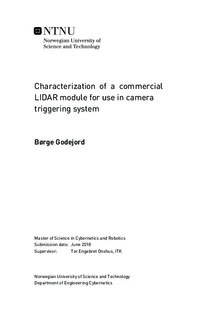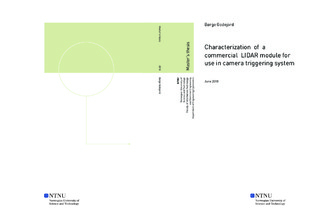| dc.description.abstract | Light based time of flight sensors have seen a rapid development from traditional rotating LiDAR sensors in the recent years. Lower price, smaller form-factor and increased robustness trough solid-state are key factors for the new modules entering the commercial marked. The development is largely driven by the work of partly and fully autonomous vehicles which require sensors to map the surroundings. This development bring new areas of use and this project regards possible use of a commercial available LiDAR-module in a electronic toll collection system.
Multiple techniques exist for detecting, tracking and classifying vehicles in tolling applications today. Where Q-Free use multiple traditional LiDAR modules to perform these tasks. If one or more of these tasks could be performed by a new smaller LiDAR module, a cost reduction and simplification of the system could be obtained. A central goal is being able to implement the new LiDAR module into an existing housing together with the OCR camera. This would reduce the need for housings, cabling, brackets, power supplies etc. and would reduce the complexity and cost of the system.
The LiDAR units used is the Leddar M16 modules from LeddarTech, where both the laser and LED version are investigated. These modules was installed in a gantry at the Q-Free test track at Lånke where all data collection and testing was performed. The project objective is to test and characterize the Leddar-modules for detecting passing vehicles, with the purpose of triggering a OCR camera that capture the number plate. This characterization is divided into five tests; sensor configuration, vehicle variation, vehicle speed, weather conditions and multiple close driving vehicles. These tests forms the basis for evaluating the sensor trough post processing and analysis of the collected data. The factors are investigated to see how they affect the sensors ability to operate in the desired way.
Sensor configuration was investigated to find the optimal sensor settings. This test was a tradeoff between CPU load and refresh rate which was highly affected by the two sensor parameters accumulations and oversampling. Variations of vehicles is a factor a triggering sensor must handle. Hence a selection of vehicles in different form, size and color was used to see how the module responded. Vehicle speed is another central factor. This is known to influence the point cloud since time inside the sensor FoV is influenced by the vehicle velocity. Weather testing was performed to investigate limited visibility problematics and saturation of the sensor receiver lens. These are well known problems for optical time-of-flight sensors. Multiple close driving vehicles challenge sensor resolution. This ability to separate multiple objects is tested both vertical and horizontal. Hence both queue and side-by-side scenarios was investigated.
Trough these tests it is concluded that both a M16-LSR and M16-LED could be used for triggering purposes. But, the FoV size of the tested M16-LSR unit is found to be too small. A larger FoV is believed to be positive for retrieving more stable and consistent data. | |

